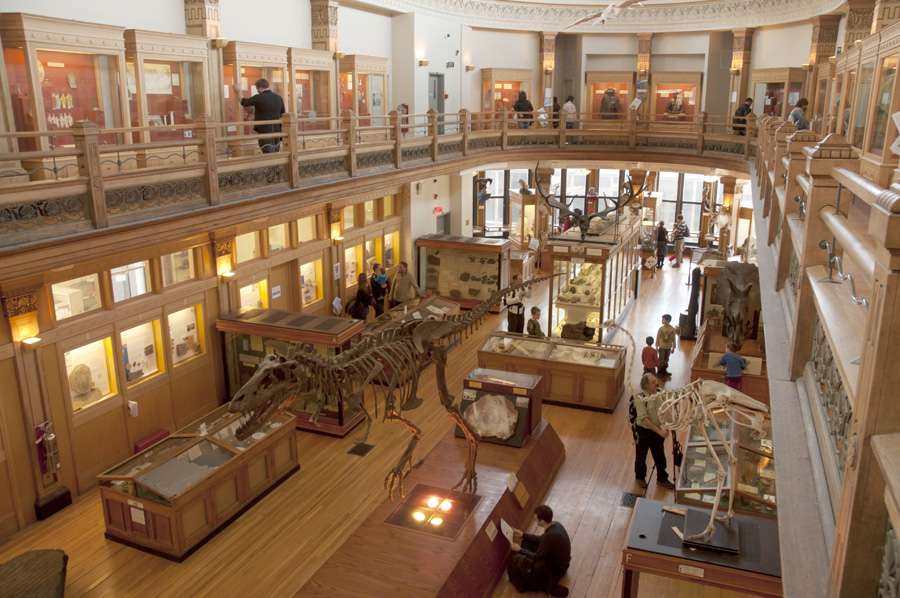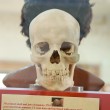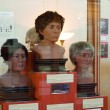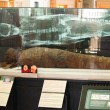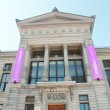It isn’t often that a museum exhibit gets to stare back at its visitors. But for the past year, those who have climbed to the third floor of the Redpath Museum have been able to lock eyes with three unexpectedly youthful new faces—model reconstructions of what the museum’s 2000-year-old Egyptian mummies might have looked like centuries ago.
These facial reconstructions, which were added to the museum’s display in 2013, were constructed by a forensic artist based on the data collected from computed tomography (CT) scans performed on the mummies at the Montreal Neurological Institute (MNI) in 2011. Since the exhibit opened, it has been featured on Le Devoir, the Globe and Mail, and the Smithsonian, and has become a staple of guided tours at the Redpath Museum.
What few of these public-interest displays touch on is that the facial reconstructions are simply the “flashy part” of an international scientific study led by the University of Western Ontario (UWO), according to Barbara Lawson, curator of the museum’s World Cultures section.
“[The reconstructions] weren’t driven by [a need for] an exhibit, but [were] simply a way of elaborating on the data the researchers [had access to],” said Lawson.
The UWO’s IMPACT Radiological Mummy Database is a project that collects information about mummification practices and ancient life from mummies worldwide without damage to the wrappings. The Redpath mummies were among the first to be scanned for the database.
Lawson explained that she created an exhibit to make the research accessible to the public and help them understand museums as living institutions that continue to work with its exhibits. Though it barely skims the surface of how such an institution operates, it is certainly a start.
More than just a museum
Like the double life led by the Redpath mummies both as subjects of research and objects of exhibition, the Redpath Museum holds a complex relationship with McGill’s academic community and the public. Administratively, the museum is a department within the Faculty of Science, hosting faculty members, graduate students, and courses in paleontology, geology, and natural history. Geographically, the museum sits next to the Y-intersection at the centre of campus, its stoic masonry and crown mouldings blending seamlessly with those of the Arts Building and Redpath Hall.
The Redpath Museum is one of the few departments at McGill that allows the public to roam its facilities and watch students at work maintaining the collections. On Nuit Blanche, when visitors of all ages come from across Montreal and line up to the Roddick Gates for the chance to go on the famous “flashlight tours,” the museum seems to belong more to the entire city than simply the university.
The museum has not always operated this way. Peter Redpath, whose family made its fortune through the Redpath Sugar Refinery, built the museum in 1881 to house the natural sciences collection of McGill’s fifth principal, Sir William Dawson. Dawson had been offered a position at Princeton, but what he truly wanted was a state-of-the-art research institute where he could complete his work.
“For scientists like Dawson, at his time, [such an institute] would have been a museum,” said David Green, the Redpath Museum’s current director. In the 19th century, natural history—a discipline with origins tracing back to Aristotle—was experiencing a renaissance as the works of naturalists like Charles Darwin began to push the study of organisms away from descriptive taxonomy and into the realm of scientific theory.
Consequently—and driven by the era’s colonialism—scientists became interested in collecting specimens from around the world to catalogue and study at home. The first natural history museums were built to facilitate the research and teaching surrounding these specimens.
The Redpath Museum was this kind of an institution from the start.
“The different floors were crowded with stuff [from Dawson’s collections],” said Green. “He had his office in the museum, could do his [scientific] studies here, and did his classes in the auditorium at the back of the museum.”
In the 1950s, the museum began to reinvent itself as a public institution by renovating exhibits and encouraging school groups to visit, in addition to keeping up with its scientific research. However, from 1971 to 1985, financial pressures caused McGill to close off public access in order to focus on teaching and research.
“[This meant that] if the museum goes too far in [the] direction [of being a public institution], we could be accused of being not central to the mission of the university, which is research and teaching [….] There’s a balance that has to be struck between these things,” said Green.
Far from fostering exclusion, the museum’s outreach office feels that the university affiliation actually enhanced its public appeal.
“[Visitors] feel quite privileged,” said Ingrid Birker, the museum’s science education and public outreach coordinator. “The texts [on display] are written by content experts who happen to be professors who are teaching the material, and [they] don’t shy away from the scientific terminology.”
According to Natalia Toronchuk, a public education curriculum developer and former student volunteer at the museum, the exhibits’ minimal design elements exude the feel of a workplace.
“You have a sense of [being able to] trust what’s said, because you know there are experts working right behind the door,” she said.
Student and public participation
Today, visitors from the public seem at times to have a much bigger presence than casual student visitors from within McGill.
On Sunday afternoons, the museum hosts film screenings and family workshops.
“We serve easily 300 people [on Sundays], and they’re the public, not McGill students,” said Birker. “[On weekdays,] we get students sent by their CEGEPs to do projects—high school students, […] not always students from McGill necessarily.”
On the students’ side, past and current members of the Redpath Museum Club (RMC)—a student group that volunteers to lead tours at the museum and act as liaisons for the student community—have noted a lack of awareness of the museum’s resources in the wider student body.
“[There’s] a history of Montreal book [Montreal: Seaport and City] by Stephen Leacock where he mentions [that] people ‘have lived and died’ without ever walking into the [Redpath] Museum,” said Isabel Luce, a former president of the RMC. “That’s very much true. I meet fourth-year [students] who [have] walked by the museum and don’t even realize what’s inside.”
It was partly the student community’s lack of engagement with the museum that motivated Donald Fowler, now a PhD student researching evolutionary science at the museum, to start the RMC as an undergraduate student in 2005. Apart from students’ lack of knowledge of what was on display, Fowler was concerned that students were unaware of the ways that the museum could be used as a resource for their academic or professional interests.
“There wasn’t a way for students to get involved at the museum,” said Fowler. “[The RMC] was [made] to create a place for people to figure out what their interest is, [and] how to get involved in it—be it public education, guiding, or [the museum’s] research.”
During Luce’s time as president of the RMC in 2010, the club launched a student version of the Redpath Museum’s popular Nuit Blanche flashlight tours in collaboration with the Students’ Society of McGill University (SSMU). The tours are attended every Fall by more than 100 students.
“[The student flashlight tours] are meant to appeal to the people who walk by every day,” said Luce. “There’s a lot of different outreach programs at the museum that target a wider group of [the public], but there’s a need to [add] variety to that.”
Improving accessibility
Part of students’ frustration with the Redpath Museum’s uneven appeal—successfully bridging its academic research with public interest, but skipping over the McGill student community in between—is simply a problem due to a lack of resources. There is insufficient space, funding, and staff at the museum to provide equipment or assistance to every student who wishes to work with the objects. The RMC does not provide students with access to the labs and the collections at the museum. Students intending to use the collections must first submit a research proposal and a statement outlining the specimens required.
According to Green, another reason for these restrictions is the need to fulfill the mandate of the museum as a reputed academic institution.
In the Mummies and World Cultures collections, Lawson is the only staff member able to assist students who wish to use collections for independent research. Priority is given to doctoral or masters’ students, then to undergraduates who are writing honours theses or researching topics that specifically target objects which Lawson herself is currently working on.
Students will also occasionally access the collection through museum visits that they go on as part of their courses. In professor Michael Fronda’s HIST 450 course Ancient Historical Methods, students are given the chance to work with the museum’s Roman coin collection under Lawson’s supervision. Students have gone on to make independent discoveries about items in the collection and pursue similar research at the graduate level.
“I had one student [who] tried to catalogue all the unpublished coins [at the museum] that [were] not on display, including […] a mystery coin [that] I assumed was just a forgery,” said Fronda. “But he figured out it was an early modern reckoning token [that] was used in banking houses […] as a placeholder for counting [accounts].”
Katrina Van Amsterdam, a graduate student in classical studies who took Fronda’s course as an undergraduate, said that she has used coins in many other papers since that class.
“The visit to the Redpath Museum [was] instrumental for [giving] me a better grasp of what to look for and how to interpret these objects,” said Van Amsterdam. “It was wonderful to be allowed to look at the evidence […] in a personal manner.”
Other students like Toronchuk and Jacqueline Riddle—another former president of the RMC—have volunteered to lead public tours and leveraged the experience into outreach or curatorial opportunities at Redpath and other museums. For now, however, the only way that the majority of students are able to discover the academic resources available at the museum is by participating in certain courses, such as the one taught by Fronda, the anthropology department’s Human Evolution, or the Faculty of Religious Studies’ Religions of the Ancient Near East.
In these cases, when the arrangement works, it does so extremely well. For Toronchuk, the museum’s greatest strength for both the student and the public is in inspiring curiosity.
“[It’s the] kind of Aristotelian wonder that [an educational] institution is supposed to be about,” she said. “It’s not just learning […] and it’s in some ways even more valuable [than learning].”
This is not a far cry from what Fronda has observed in his students’ reactions to their opportunity to interact with the collections.
“There’s a certain kind of wow factor, […] a kind of visceral, emotional attachment to the material that I hope carries on and [will] encourage them to do more with antiquities,” Fronda said.
For Lawson, it is also this sense of continuity with a century’s worth of notable research and learning that, combined with the cutting edge research taking place at the museum currently, makes the museum an important resource for both the McGill community and the public. This consideration underpinned how she chose to present the mummies’ new faces to the public.
“[The museum has] a symbiotic relationship with research interests at McGill and [other] researchers around the world,” said Lawson. “We also display what the public is interested in […] in a way that illustrates the complicated things in an accessible way […] One way of serving [all of these people’s] needs and interests is to have exhibits that connect to the sorts of question that they are asking.”
